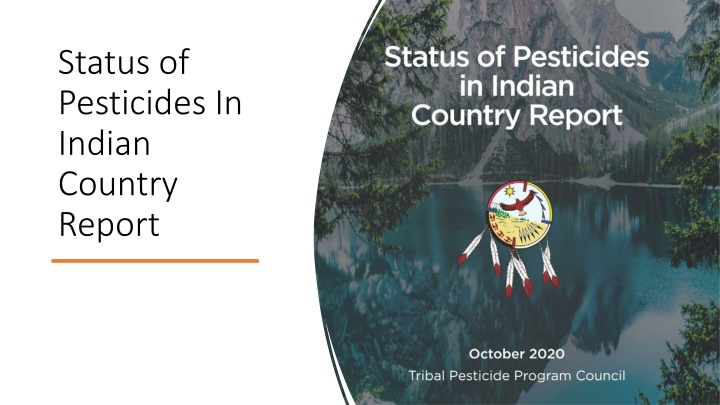
Insight into Pesticides in Indian Country Reports
This content highlights the role of the Tribal Pesticide Program Council (TPPC) in addressing pesticide issues, compiling major concerns affecting Indian Country, conducting risk assessments, providing education and training, and advocating for effective pesticide management. It stresses the importance of EPA's responsibility in implementing environmental statutes, the need for adequate funding, and the challenges in enforcing compliance. The report is a valuable resource for tribal leadership, EPA, federal agencies, and those interested in understanding the impact of pesticide use on tribes.
Download Presentation

Please find below an Image/Link to download the presentation.
The content on the website is provided AS IS for your information and personal use only. It may not be sold, licensed, or shared on other websites without obtaining consent from the author. If you encounter any issues during the download, it is possible that the publisher has removed the file from their server.
You are allowed to download the files provided on this website for personal or commercial use, subject to the condition that they are used lawfully. All files are the property of their respective owners.
The content on the website is provided AS IS for your information and personal use only. It may not be sold, licensed, or shared on other websites without obtaining consent from the author.
E N D
Presentation Transcript
Status of Pesticides In Indian Country Report 1
Member-based organization with more than 66 members and 44 tribes and tribal organizations. Is a tribal technical resource and program and policy development dialogue group, focused on pesticide issues and concerns. Can assist in building tribal pesticide programs. Can assist in providing pesticide education and training. Can assist with researching, developing and presenting a broad range of tribal pesticide-related issues and concerns And serve as a resource for tribes interested in Integrated Pesticide Management and pollinators. What is the TPPC? 2
Report Sections Section 1 Direct Implementation Section 5 Pesticide Enforcement and Compliance Section 2 Risk Assessments for Pesticides Section 4 Pesticide Education and Training Section 3 Pesticide Funding 3
Reasons for the Status of Pesticides in Indian Country Report Compile in one place a periodic list of the major pesticide-related issues and concerns that affect Indian Country. Educate tribal leadership. Educate EPA and other federal agencies. Serve as an advocacy tool. Anyone else who has a genuine interest in Indian country and how pesticide use impacts tribes. 4
Implementation of federal environmental statutes in IC is the responsibility of EPA. Risk assessment models are unable to account for unique tribal activities that inadvertently expose tries to pesticides. Funding is an issue EPA and Tribes regularly face in support of their efforts to manage pesticide use in Indian Country. Appropriate pesticide education and training courses are needed for tries to ensure proper pesticide use on their lands. Enforcement and compliance activities are integral to managing pesticide use in Indian country. Summary of Report 5
Imperfect Report A living document that is not all-inclusive and requires periodic updates. There will be changing circumstances and changing data hopefully more data! Out of this partnership will come/has developed: Compilation of a Bed Bug issue paper followed with a Bed Bug Educational Package. Establishment of a Pollinator Protection Work Group first Monday of every month. Establishment of Risk Assessment Work Group to coordinate with NTTC. Establishment of a Direct Implementation Work Group to learn and understand about EPA direct implementation responsibilities under FIFRA and other EPA Programs. Development of first-class website. 6
Over 300 Indian Reservations in the U.S. Cover 55 million acres from California rancherias to 17 million acres for the Navajo Nation. Something to Keep in Mind 38 million acres of off-reservation lands are co-managed by some tribes with other tribes and public agencies Ceded Territories and Usual and Accustomed Areas. Tribal lands contain over 10,000 miles of streams and rivers and 730,000 acres of lakes and impoundments. Tribal lands provide vital habitats for more than 525 federally listed animals and plants, many ecologically and culturally significant to tribes. 7
Direct Implementation The implementation of federal environmental statutes in Indian country is the responsibility of EPA with program implementation authority retained by EPA in the absence of federally-approved program. Supportive EPA Activities Education & Outreach on pesticide safety and control and alternatives. General and specific pesticide-related training (e.g., bed bugs, pollinator plans). Helping develop pesticide codes and plans Technical assistance 8
Direct Implementation Recommendations EPA and Tribes must think outside the box because of the constraints of funding. Well-defined communications strategy. Establishments of BMPs for the use of GAP funds regarding activities that support direct implementation. 9
Risk Assessments A risk assessment is a particular process whose intent is to estimate the risk to a target human population or ecological resource (e.g., animal, plant, water). Purpose is to determine the exposure level of a pesticide that can be tolerated by a human being before health is harmed. Pesticide exposure and their effects growing problem in IC and often related to cultural and subsistence practices that current models used by federal agencies do not always consider. Hunting/fishing, gathering of materials, edible and medicinal resources, prep of materials, consumption of plants and animals, ceremonial activities, etc. 10
Risk Assessments Recommendations Update current models to account for tribal pesticide exposure pathways. Consider: Tribal Lifeways Exposure Scenarios Geographic, Economic and Technological Characteristics Enable the use of qualitative data to paint the better picture. Work with tribes to identify specific case studies containing tribal pesticide exposure scenario pathways can be tested. 11
Funding 12
Funding Recommendations Increase funding for EPA Cooperative Agreements. Create more guidance for pesticide programs and other pesticide related activities, such as sampling, equipment and lab fees. Establish and enhance sustainability of pesticide programs. Increase tribal-specific training on FIFRA. Make additional STAG (State and Tribal Assistance Grant) and other federal funding competitively available to tribes. 13
Pesticide Training and Education - Struggles Tribes struggle to identify and obtain pesticide education and training resources to address particular needs and challenges due to: types, locations, scheduling, notification, space and funding. Lack of pesticide education and training courses available to tribes w/o cooperative agreements. Web based materials unable to fully inform WPS works and handlers. 15
Pesticide Training & Education - Recommendations Sufficient funding annually for various tribal-specific pesticide education and training courses (codes). Work with trainers, including cooperative extensions, to add tribal- specific information on pesticide education. Sufficient training for Train the Trainers for WPS certification. Establish in-person pesticide education and training locations that accommodate tribes in rural locations. Year-round, flexible pesticide education and training course schedule. Encourage PREP to have tribal participation 16
Pesticide Enforcement & Compliance FIFRA primary pesticide regulatory standard to be followed in Indian country Covers manufacture, distribution, use, storge, container recycling and disposal of pesticides. Tribes can enter into cooperative agreements with EPA Inspection types: Use, Marketplace, Producer Establishment, Restricted-use Pesticide Dealer, Certified Applicator and Import. 7 tribes with C&T Plans tribes train pesticide applicators in accordance with national standards. 17
Pesticide Enforcement & Compliance - Struggles Funding limits number of inspectors and resources to fulfill inspection duties. Response time from EPA can take up to several weeks to over a year. Inspection commitments (set at 25) negotiated consider number of tribal staff, miles between inspection sites and fuel costs that grant budget may not cover. States pesticide inspectors entering tribal jurisdiction without an MOU or notification. 18
Pesticide Enforcement & Compliance - Recommendations Create a public document that identifies a feedback mechanism regarding tribal enforcement referrals and establishes a timeline for each type of enforcement and time period EPA must respond. Tribes, with cooperative agreements, should use their mid-year and end-of-year reports to follow up with EPA project officers. Consider available financial resources and tribal capacity to determine inspection commitments. OECA should include in the next FIFRA Cooperative Agreement Guidance that a State inspector may not conduct an inspection on a tribe s land unless have an MOU with the tribe. Written guideline on how treaty-protect resources located on state and federal lands 19
Status of Pesticides in Indian Country Report https://tppcwebsite.org 20






















